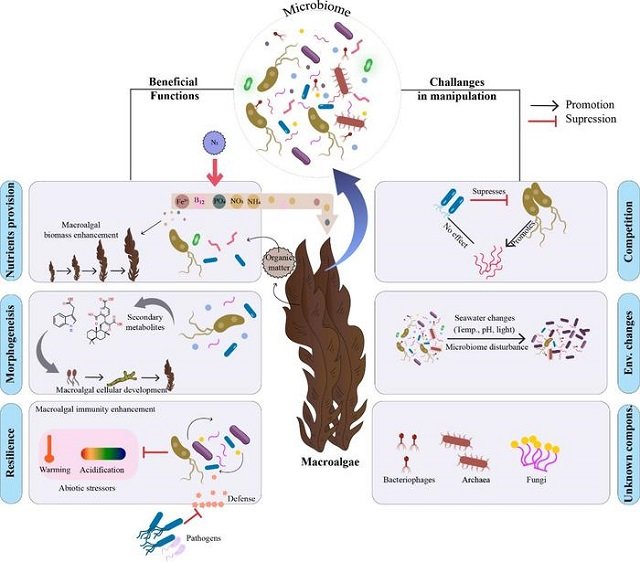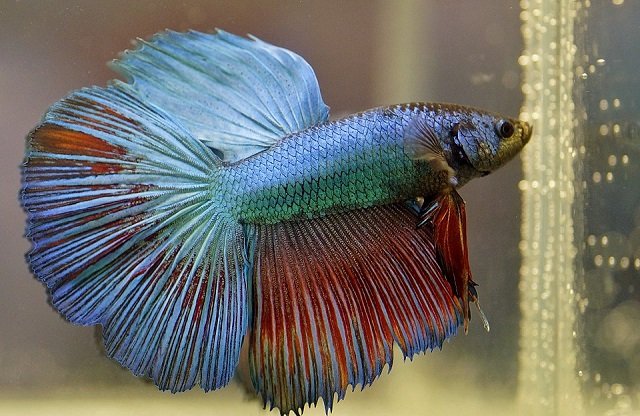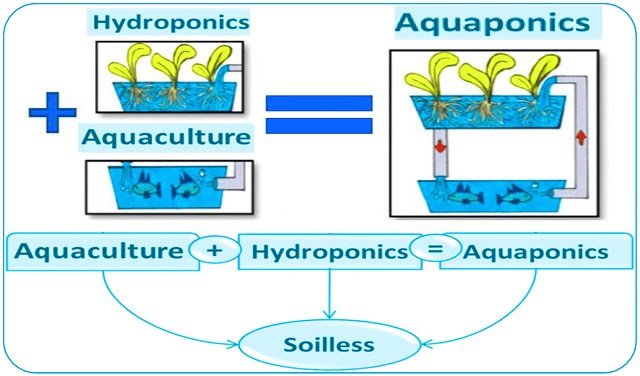
The urgent need to mitigate climate change has spurred interest in ocean-based carbon sequestration strategies, with large-scale macroalgae cultivation emerging as a promising solution.
Macroalgae, or seaweeds, offer a sustainable pathway for carbon capture and utilization while providing valuable biomass for various applications. However, the success of macroalgae cultivation depends on understanding and optimizing the complex interaction between the host and its associated microbiome.
Researchers from the Chinese Academy of Sciences, Shandong Energy Institute, Qingdao New Energy Shandong Laboratory, and Xiamen University have published a scientific review exploring the potential of manipulating macroalgal microbiomes to enhance growth, resilience, and carbon sequestration capabilities.
The macroalgal holobiont: A complex interaction
- 1 The macroalgal holobiont: A complex interaction
- 2 How does the microbiome affect macroalgae?
- 3 Challenges in manipulating the macroalgal microbiome
- 4 Approaches for Microbiome Manipulation
- 5 Applications of microbiome manipulation in macroalgae cultivation
- 6 A roadmap for future research
- 7 Conclusion
- 8 Entradas relacionadas:
Macroalgae are not solitary organisms but complex holobionts, comprising the host and its associated microbial community. This intricate assembly plays a crucial role in various aspects of macroalgal biology, including nutrient cycling, growth regulation, pathogen defense, and stress responses.
The composition and function of the macroalgal microbiome are influenced by numerous factors, including host species, environmental conditions, and cultivation practices.
“A diverse community of microbes lives on seaweed, acting like probiotics for algae: specific microbes can protect seaweed from diseases, provide essential nutrients, and help them thrive under challenging conditions,” explains corresponding author Yongyu Zhang. “This is particularly important as our previous study showed that rising ocean temperatures and acidification are likely to increase pathogenic diseases in seaweed.”
How does the microbiome affect macroalgae?
The microbiome significantly impacts the productivity and resilience of macroalgae by influencing several key processes. Here are some highlights of its effects:
Nutrient cycling
Microorganisms associated with macroalgae play a critical role in nutrient cycling. For example:
Stay Always Informed
Join our communities to instantly receive the most important news, reports, and analysis from the aquaculture industry.
- Nitrogen-fixing bacteria increase the availability of nitrogen, essential for macroalgal growth.
- Other bacteria solubilize inorganic phosphates, making them more accessible to macroalgae.
- Some microbes produce siderophores, which enhance iron uptake critical for photosynthesis.
Growth promotion and biomass accumulation
Beyond nutrient cycling, the microbiome can directly enhance macroalgal growth and biomass accumulation. Certain bacteria synthesize phytohormones and other compounds that stimulate algal growth. For instance:
- Auxin production, such as indole-3-acetic acid (IAA) by specific bacteria, regulates macroalgal growth.
- Certain bacterial strains influence algal morphogenesis, affecting growth rates.
Stress and disease resistance
The microbiome plays a key role in protecting macroalgae from environmental stress and diseases. Beneficial microbes can help macroalgae tolerate changing oceanic conditions, such as temperature and salinity fluctuations. Additionally, certain bacteria protect macroalgae from pathogens. For instance, Vibrio alginolyticus protects Saccharina japonica from bleaching diseases. A beneficial microbiome can prevent harmful organisms from colonizing.
Carbon transformation
The microbiome also influences macroalgal carbon fixation and sequestration. Bacteria associated with macroalgae can modulate carbon fixation efficiency and allocation patterns. Furthermore, the microbiome contributes to carbon sequestration by transforming dissolved organic carbon (DOC) released by macroalgae into recalcitrant forms via the microbial carbon pump (MCP). This transformation produces recalcitrant DOC (RDOC), enabling long-term carbon sequestration.
Challenges in manipulating the macroalgal microbiome
The research highlights key areas for overcoming current limitations in microbiome manipulation, such as a comprehensive understanding of microbiome composition and timing of inoculation.
Despite its potential, manipulating macroalgal microbiomes to achieve desired outcomes faces several challenges:
- Limited understanding: The specific functions of many microbial members within the macroalgal microbiome remain unknown.
- Host specificity: Interactions between the host and microbes are highly specific, necessitating an in-depth understanding for successful microbiome engineering.
- Environmental variability: Dynamic marine environments significantly affect microbiome composition and function, complicating predictions of long-term effects.
- Scalability: Transitioning microbiome manipulations from laboratory to large-scale cultivation systems remains a significant hurdle.
“Early life stages of seaweed, being more susceptible to microbial colonization, present a critical window for establishing beneficial microbes that could persist throughout the seaweed’s lifecycle,” says first author Shailesh Nair. “Some seaweeds may even pass on these beneficial microbes to their offspring, suggesting potential long-term benefits across generations.”
Approaches for Microbiome Manipulation
The researchers propose a framework for future macroalgal microbiome manipulation, emphasizing integrating advanced technologies such as multi-omics, high-throughput isolation techniques, AI-based tools, and robust validation.
“Microbial solutions should be implemented for sustainable macroalgae cultivation,” Zhang adds. “By harnessing the power of beneficial microbes, farmers could create more stable and productive seaweed farms, making large-scale ocean farming more feasible than ever.”
According to the study, several approaches are being explored to manipulate macroalgal microbiomes:
- Probiotics: Introducing beneficial microbes to enhance host health and resilience.
- SynComs: Designing and assembling synthetic microbial communities with specific functionalities.
- Bioaugmentation: Increasing the abundance of natural beneficial microbes within the microbiome.
- Antibiotics: Identifying and eliminating harmful microbes from the microbiome.
Applications of microbiome manipulation in macroalgae cultivation
According to the scientists, microbiome manipulation holds the potential to:
- Enhance growth and productivity: By optimizing nutrient cycling and promoting efficient biomass production.
- Improve stress tolerance: By increasing resistance to environmental stressors, such as temperature fluctuations, nutrient limitations, and disease outbreaks.
- Boost carbon sequestration: By promoting efficient carbon fixation and enhancing the production of recalcitrant carbon compounds.
A roadmap for future research
To fully leverage the potential of microbiome manipulation for sustainable macroalgae cultivation, a multidisciplinary approach is required:
- Multi-omics analysis: Integrating metagenomics, metatranscriptomics, and metabolomics to comprehensively characterize the macroalgal holobiont.
- Functional studies: Investigating the specific functions of key microbial members within the microbiome.
- High-throughput screening: Developing efficient methods for isolating and characterizing new beneficial microbes.
- In vivo validation: Rigorous testing of microbiome manipulations in controlled and field environments.
Conclusion
Manipulating macroalgal microbiomes offers a promising pathway to enhance the sustainability and productivity of large-scale macroalgae cultivation. By addressing current challenges and leveraging cutting-edge technologies, we can unlock the full potential of these microbial communities to support sustainable carbon sequestration and contribute to a more resilient and sustainable future.
The study was funded by the National Key Research and Development Program of China, the Natural Science Foundation of China, the China Postdoctoral Science Foundation, the Shandong Province Postdoctoral Fund Project, the Youth Innovation Promotion Association of CAS, the Taishan Scholar Foundation of Shandong Province, and the Ocean Negative Carbon Emissions (ONCE) Project.
Contact
Nianzhi Jiao
State Key Laboratory of Marine Environmental Science, Xiamen University
Xiamen, China, 361101
Email: jiao@xmu.edu.cn
Yongyu Zhang
Qingdao Institute of Bioenergy and Bioprocess Technology, Chinese Academy of Sciences
Qingdao, China, 266101
Email:zhangyy@qibebt.ac.cn
Reference
Nair, S., Zhang, Z., Wang, X., Zhang, B., Jiao, N., & Zhang, Y. (2024). Engineering microbiomes to enhance macroalgal health, biomass yield, and carbon sequestration. Green Carbon. https://doi.org/10.1016/j.greenca.2024.11.001
Editor at the digital magazine AquaHoy. He holds a degree in Aquaculture Biology from the National University of Santa (UNS) and a Master’s degree in Science and Innovation Management from the Polytechnic University of Valencia, with postgraduate diplomas in Business Innovation and Innovation Management. He possesses extensive experience in the aquaculture and fisheries sector, having led the Fisheries Innovation Unit of the National Program for Innovation in Fisheries and Aquaculture (PNIPA). He has served as a senior consultant in technology watch, an innovation project formulator and advisor, and a lecturer at UNS. He is a member of the Peruvian College of Biologists and was recognized by the World Aquaculture Society (WAS) in 2016 for his contribution to aquaculture.




